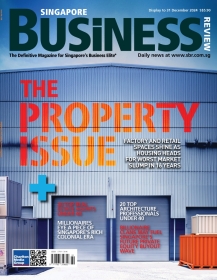Singapore
How does South East Asia beat the West in driving global economic growth?
With the Singapore Economic Development Board reporting that factory outputs have increased 3.9% since July, and 21.7% from a year earlier, national economic growth is looking strong.
How does South East Asia beat the West in driving global economic growth?
With the Singapore Economic Development Board reporting that factory outputs have increased 3.9% since July, and 21.7% from a year earlier, national economic growth is looking strong.
SG banks sustain momentum with double-digit loan growth
DBU loans grew 29.7% yoy while loan-to-deposit ratio reached an all-time high of 83.7%.
Take a look at the current hiring trend
In Singapore and across the rest of Asia, a rapidly growing middle class has resulted in a booming demand for products and services that support an urban lifestyle. Sectors as diverse as financial services, hospitality, construction, manufacturing, telecommunications and fast moving consumer goods are benefiting from this growing class of effluent consumers, despite an uncertain global outlook.
The Singapore GP is genius country marketing
The excitement is growing amongst the hundreds of thousands of Grand Prix (GP) (and Linkin Park) fans as the Singapore GP comes closer and closer. But it’s also growing amongst the Singapore tourism board who have been masters at using the Grand Prix to be the ultimate marketing vehicle for the Singapore country brand. Singapore GP is a unique event in the world of F1 in that it’s a dazzling night race on the streets of Singapore. The decision to have a night time race was a masterstroke by the Singapore government as it shows all the glitter and sparkles that Singapore has to offer in its best light. The decision to go with a street circuit was the icing on the cake as the street circuit takes the hundreds of millions of viewers around one of the most beautiful cities in the world or two hours on prime time TV. One of the most exciting things about it being a street circuit is that it takes months of preparation to actually create the circuit. It slowly builds and builds as more and more lights go up, more and more barriers go up and more and more stands go up. Taxi rides around what slowly becomes the actual GP race track senses a thrill of excitement down your spine in anticipation. We’re now into the final week before the roads become closed and the whole city country celebrates the influx of even more visitors and pride of seeing the race on TV knowing the glimmering beauty of Singapore will be seen across the globe. Singapore Tourism board cleverly use the GP as no other country marketing team do, to create awareness, shatter the misconceptions and communicate the brand values of Singapore. The British Tourism body have a long way to go to be able to market the British GP at less than glamorous Silverstone in quite the same way. With the addition of the iconic Marina Bay Sands integrated resort (now with it’s sister casino resort at Singapore’s Sentosa island larger than Las Vegas) overlooking the entire circuit along with the jaw droppingly stunning CBD all lit up Singapore looks like the modern, sophisticated, business focused, international hub that it is and why so many businesses are moving to Singapore at the expense of Europe and America. Linkin Park top the bill of musical entertainment – another innovative part of the whole F1 experience in Singapore . All free when you buy an F1 ticket. Personally I did it the other way around, bought the F1 ticket to see Linkin Park and gained a free race on top!
You can EASILY avoid becoming a marketing dinosaur!
Researchers has it that the dinosaurs, as dominant as they were during their time on Earth, got extinct not because of the massive asteroids that hit Earth but because they could not adapt to the change in the climate at that time. Their extinction was gradual, they say.
If you're young and business-minded, here are some tips for you
Startup landscape in Singapore
To go global, Singapore companies need Market Intelligence
Singaporean companies that have made it big on the international stage can be counted on the fingers of one hand: Capitaland, Singtel, Singapore Airlines (in part thanks to the nature of its business, to be fair), Singapore Technologies, DBS... it becomes difficult to think of more. Compared with the achievements of some other Asian economies that modernised post-WWII – think Japan, Korea, Taiwan – while ‘brand Singapore’ is well established globally, few of its home-grown companies have succeeded outside their home territory in any significant way. There are multiple reasons for this state of affairs, some historical, some cultural and others geographical. The first two will take many years to change, however the constraints imposed on companies’ efforts to expand overseas by Singapore’s geography and its effect on management’s mind-set can be addressed relatively easily. That’s where Market Intelligence comes in. As a small and compact market with relatively homogenous sets of consumers and B2B customers, Singapore is very well known territory to its home-grown market leaders. They know what their customers like, how much they are willing to pay for it and who they are competing with for those dollars. In other words, doing business in Singapore is second nature to these home-grown companies. Not so the rest of the world. Most overseas markets worth exploring (and there are many, with markets many times the size of Singapore’s) are more complex, harder to understand, more heavily competed, and above all just very different from Singapore. But help is at hand. Market Intelligence (MI) – especially end-to-end MI that makes use of multiple information sources supplemented by strategic analysis that prioritises options and produces strategic recommendations grounded in hard facts, is a highly cost-effective means of identifying overseas expansion opportunities and making rational decisions about global growth. Market Intelligence has two main building blocks, and companies venturing overseas or thinking of doing so need both. First, ongoing market monitoring, which tracks a company’s international business environment, including its existing and potential markets, competitors, regulations, disruptive technologies and so on. This keeps all the key decision makers informed on a frequent and regular basis, often via an automated system that selects the information that is most relevant to each stakeholder, with a special ‘feed’ for the CEO. And secondly, issue-driven projects, which look more in-depth at a particular strategic opportunity such as a possible acquisition, a new market entry or a competitive gap, or a threat, such as an unexpected competitor, a budding price war or a squeeze on supply chain margins. In GIA’s latest global market intelligence survey of 989 companies, 91% of companies in the Asia-Pacific region said they had benefited from Market Intelligence, and 83% planned to spend more on Market Intelligence in the next two years. But adopting Market Intelligence and making it work for the company is something that has to come from the very top. The companies that benefit most from Market Intelligence have the function reporting directly to the CEO or at most one layer removed. Those companies that use Market Intelligence less successfully have up to four layers between the MI head and the top boss. Global success stories which relied on Market Intelligence to assist their meteoric rise during the 1980s and 1990s, and still rely on it heavily today, include Motorola, Shell and GM. Maybe one day that list will be joined by a Singaporean brand name – if so it will be one with a visionary CEO. Pete Read, Senior Vice President at Global Intelligence Alliance
Get a life!: Singaporeans struggle from work-life imbalance
Workaholics as they are, 67% of Singaporean professionals did not take all their holiday allowance in 2010.
Global economic turmoil takes its toll on Asia Pac debt issuances
Debt capital market volume declined 42.4% to US$109.3b in Q3 2011.
Remember this: Always be educating to your employees
The speed of change in business has accelerated tremendously over the last decade.
What to do with your company’s unending information overload
In its latest annual analysis of the fastest-growing firms in Singapore, credit and business-information bureau DP Information Group found that 217 companies here managed to turn in net profit and achieve at least 10 per cent turnover growth each year over the last three years.
Networking – What I learned from my in-camp training
Most should know that no one is allowed to bring a camera phone to a Singapore Army camp. It just happens that I am in the midst of my reservist, and without my time sapping iPhone by my side, we did the next best thing. We talked.
Net Work: manage your jump to the online bandwagon
Technology offers employers, recruiters and hiring managers powerful new recruitment tools, but the pace of change can be an obstacle and face-to-face methods need to remain central to the process. Many organisations rushed to incorporate social media in their recruitment process, even if they were not sure how to put their new tools to effective use. We’ve seen countless cases of organisations rushing into the online networking space before developing a proper strategy or thinking about what they want to achieve. With the rise in popularity of Web 2.0 tools and technologies like Facebook, wikis and blogs, all the talk has been about how these online spaces could help firms find those elusive passive candidates, and many organisations - recruiters included - rushed to establish an online presence. Here was a medium that provided free access to thousands of potential candidates. But without thinking ahead, the increasing use of these mediums means employers no longer totally own their brand. We have to accept that allowing employees to blog and discuss matters on social forums isn’t without its risks and employees must remember that they are representing the company. This is where a clear strategy and policy around what employees can and cannot do comes into play. There is more to consider than simply broadening your search base. As we all know, it’s quality not quantity that matters. If companies want to be active in online communities, their image and reputation have to be carefully managed and monitored, and they need to act quickly to address any issues because they can become widespread very quickly and have a significant impact on candidate attraction. That’s not to say we should steer away from using social media. Technology has an important part to play in the recruitment process. With many candidates now being much more strategic in their approach to online networking, taking advantage of the sites linked to career-related groups and forums is a sensible move. But this form of networking must not be done at the expense of face-to-face methods, which remain central to the recruitment process. We need to look at it as just one of the attraction tools that we can use. Taking the time to get to know someone is still crucial in identifying the right role for them and picking up the phone to candidates or meeting them in person just can’t be substituted. Above all, technology and social media must be used to add value to the recruitment process. Used at the right time and in the right way, it’s a highly effective way of communicating. Used exclusively, at the expense of speaking to people, it becomes counterproductive. Nobody uses only one method of communication or interaction – it’s about using the right method at the right time in the right way. For any organisation considering incorporating social media into the recruitment process, we would advise them to:
Asia Pac IPO proceeds reach US$157.2b in Q3 2011
There are 1228 issues year-to-date, marking the third highest level of ECM activity in Asia since 2007.
Sheng Siong Group's US$95m IPO is fifth biggest in Q3 2011
The top spot still belongs to Hutchison Port Holdings’ US$5.5 billion IPO.
Just inspire your top player with that performance-related pay
I never took kindly to the idea of respecting my elders and betters. There is a fallacy in that smug paternalistic expression – because your elders are not necessary better than you. As it happens, I have immense respect for a number of people from an earlier generation, because they have seen and experienced more than I have, and learnt from their experiences. It is not age that makes the difference, though, because many of their contemporaries remain as ignorant now as they were then, despite all their extra experience.
How enterprise transparency can help your bank?
Virtually every activity within an organization in Singapore involves business content. The majority of operational activities involve creating, capturing, collaborating around, reviewing, reporting, publishing, and preserving that content. The product of these activities are essentially business records, which in turn need to be classified, have appropriate retention policies applied, and tracked throughout their lifecycle.



















 Advertise
Advertise


















